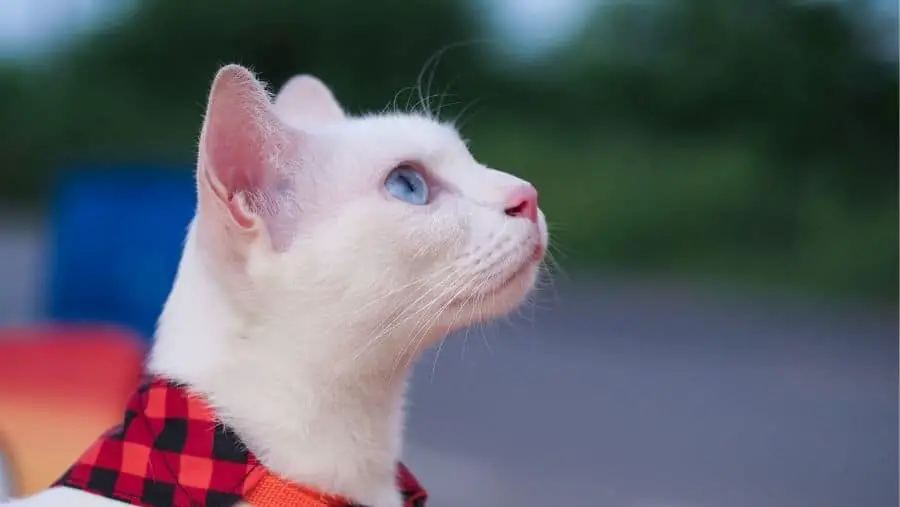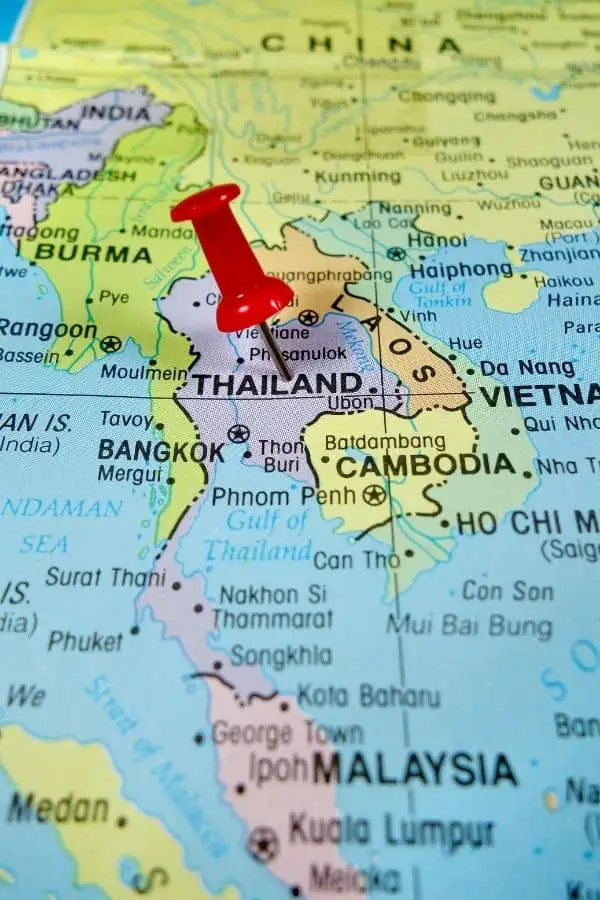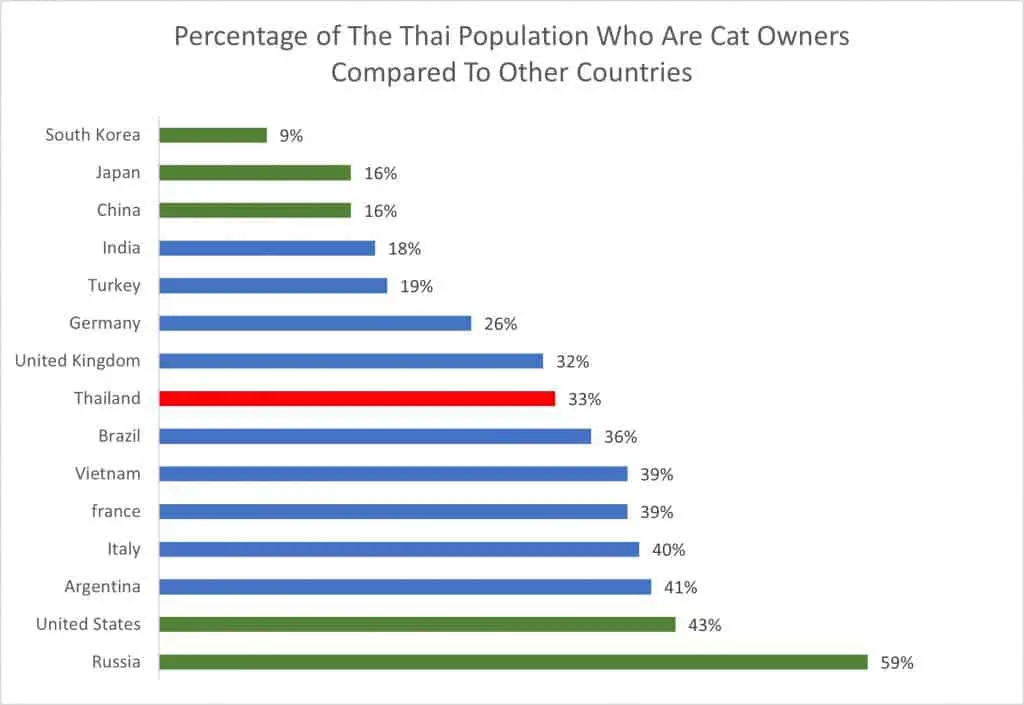More Meows is an Amazon Associate. As an Amazon Associate we earn from qualifying purchases. We may also earn commissions if you purchase products from other retailers after clicking on a link from our site.
The lush forests, sparkling beaches, and exotic culture are not the only lure Thailand can offer passionate cat enthusiasts. The incredible cat culture in Thailand is richly nuanced and varied. A cat enthusiast may be entranced by Buddhist monks’ warm hospitality towards their cat residents, astounded by the casual acceptance of the massive stray cat populations, or absorbed into the complex world of cat breed preservation in Thailand.
Cat ownership is rapidly gaining popularity in Thailand. 33% of Thai nationals own pet cats. Cats represent the second-largest pet group in Thailand behind dogs. TIMBA is working hard to save the five remaining domesticated cat breeds native to Thailand. These cats are considered national treasures.
Thai cat culture is enough to make any cat lover rub their hands in glee. From the vast array of stray cats to the populous temple cats and the proudly native Thai cat breeds, there is something for everyone within the Thai cat community. The Thai folklore and ceremonies surrounding cats can be just as fascinating as the cats themselves.
In this article, I am going to recommend a cat stroller on Amazon (affiliate link) that I think is great due to its space for the cat and its versatility. Check it out: Check Out This Great Cat Stroller On Amazon.

Are Cats Sacred In Thailand?
The Thai people always have revered cats and incorporated them into their culture and daily lives. People who practice Buddhism exalt the lives of all animals, including cats. All creatures are welcomed with gentleness and dignity.
Feral and abandoned cats are never turned away from the monasteries. As such, the monasteries have become important informal cat sanctuaries. These sanctuaries offer a haven to many of the land’s vulnerable cat populations. The cats are mischievous companions and faithful teachers to their human hosts.
Speaking of abandoned and stray cats, learn more in my article about whether stray cats die of hunger: Click Here.
Cats and Spiritual Connection
Cats’ infamous hatred of water has led to their horrified and reluctant inclusion in an annual dry season ceremony. The rural Thai population who adhere to the religious rules of Ben Nai will engage in a symbolic ritual to end the dry season and bring life-sustaining rain. The water-adverse cat is the centerpiece around which this ceremony revolves.
A female temple cat is selected and placed in a cage. The outraged feline is carried through the village, from house to house. As the procession moves through the town, they will accompany the cat with devotional songs and homage to the coming rains. As the procession stops at each house, the house occupants will welcome the singers and throw water on the cat.
Personally, I think there are better ways of walking around with a cat than in a cage. I think this cat stroller on Amazon (affiliate link) is pretty awesome due to its space for the cat and its versatility. Check it out: Check Out This Great Cat Stroller On Amazon.
Eventually, the water-hating cat representing the dry season is drenched by the people throwing water on it. Once the poor rumpled cat is thoroughly soaked, the procession returns to the temple for a feast and celebration of the coming rains.
The unharmed but soaking wet kitty is left to dry and nurse its offended dignity. Although the symbolic ceremony is not comfortable for the cat, she is not harmed. The ceremony’s illusory magic and sympathetic symbolism are essential parts of the Ben Nai culture in rural Thailand.

Humanization of Cats
In modern-day Thailand, the pet industry and cat ownership is a rapidly growing sector. As more and more Thai engage with cat ownership, there is an increased humanization of cats. Anthropomorphism is when human characteristics are given to animals.
Cats in Thailand are being increasingly regarded as beloved miniaturized furry friends and family. The anthropomorphic attitude of Thai cat owners has led to a boom in the pet industry as these owners try to provide their cats with every luxury imaginable.
Cats in Thailand
It is difficult to find definitive statistics for cat ownership in Thailand. Different studies have different results based on where and how the data was collected. When compared to other countries, Thailand shows a relatively average rate of cat ownership.
33% of the Thai population owns cats, which is significantly less than the two countries leading the chart at 59% and 43% for Russia and the United States, respectively. However, Thailand’s cat ownership far outstrips its larger neighbor, as China trails behind, with only 16% of the population owning cats.

54% of Thai people live with one or more pets. These pets range from standard cats and dogs to exotic insects, fish, and other fantastical pets. Of the 54% of Thai owning pets, 52.1% owns dogs and 39.4% own cats. Cats and dogs are the most popular pets to possess in Thailand.
One great cat that people would want to own is the “Thai” cat breed. Check out how it is similar to another great cat breed, the “Siamese Cat,” in my article on the Thirteen Beautiful Cat Breeds Similar To Siamese Cats: Click Here.
Native Thailand Cat Breeds
Thailand has a rich cat history that is fascinating to any cat enthusiast. Historical records, such as the Tamra Maew kept by Buddhist Monks, indicate that there were once twenty-three domestic distinct cat breeds native to Thailand, known as the Maew Boran.
King Rama V’s reign saw a sharp rise in the popularity and export of the native Thai cats. The exported cats were used as an outcross for the development of many other cat breeds.
Of the original twenty-three cat breeds, eighteen have gone extinct, and the five remaining Thai cat breeds are fighting for survival. The five cat breeds, prized as national treasures, are slowly being brought back from the edge of extinction by dedicated cat enthusiasts and increased social awareness of these cat’s plight.
The International Maew Boran Association (TIMBA) is a foundation dedicated to preserving the five ancient cat breeds of Thailand: the Suphalak, the Wichienmaat, the Korat, the Khoa Manee, and the Konja.
The Suphalak Cat
The Suphalak cat is a small, short-haired cat with an evenly pigmented rich red-brown coat. The Suphalak has yellow-gold eyes with brown noses and paws carrying pink undertones.
The Tamra Maew romantically describes the fur as Thong Daeng (refers to a richly pigmented copper color) and the eyes as Thuptim (the yellow gold of Thai pomegranates), which sparkle and shine like the loveliest of sun rays.
Few people have been privileged to meet the incredibly rare Suphalak cat. Although recognized as an ancient breed, the current breeding population has been decimated to two males and three breeding females. The five cats are:
- Samsen is a male Suphalak who has subsequently retired from breeding.
- Ayothaya is an active breeding male who was initially found in a monastery.
- Three breeding females, Daeng, Ayodia, and Vadhana Thong Prakaisaed
Samsen’s breeder, Kamnan Preecha, dedicated his life to preserving the Suphalak breed. TIMBA has now shouldered the mantle of breed preservation. The breeding population is being selective outcrossed with the Korat, Thai Burmese, and Konja to preserve the suphalak cats’ health.
The poetic Tamra Maew has become the definitive guide for returning the Suphalak to its former glory. Historically, Suphalak’s have been revered as harbingers of wealth and viewed as rare as gold. Considering the Suphalak’s current plight, it is safe to assume they are, in fact, rarer than gold in modern times!
The Wichienmaat Cat
The attractive Wichienmaat cat (more commonly known as the Thai cat) is the most popular of the Thai cat breeds. The Wichienmaat’s body is a cotton cream color with eight dark points (i.e., The ears, feet, face, tail) and icy blue eyes. The seal point Wichienmaat with dark chocolate brown points was popularized as an exclusively royal cat during King Chulalongkorn’s reign.
To learn more about the Thai cat, check out my article on if Thai cats shed a lot: Click Here.
The Korat Cat
The Tamra Maew gives three alternative names for the striking Korat, Si-Sawa, Maled, and Doklao. The most commonly used terms by modern Korat breeders are Si-Sawat and Korat. Lightly color cats may also be referred to as Thai Lilac or Thai Blue Point.
These cats are relatively rare, even in Thailand. With their characteristic stormy blue-grey coats and topaz or emerald eyes, the Korat is a striking cat.
The Khao Manee Cat
The Khao Manee is referred to as the “white jewel” of the Maew Boran when referenced in the Tamra Maew. With a solid white coat and exotic yellow, blue, or odd-colored eyes, these cats are prized for their elegance and friendly nature.
Although, still rare the Khao Manee is slowly making a comeback, as Thai and non-Thai breeders work together to preserve the breed.
The Konja Cat
Kamnan Preecha is the only breeder who continues to breed the Konja cat. These gleaming black cats are prevalent in almost every monastery in Thailand. The commonality of the breed has reduced Thai breeder’s interest in preserving the common Konja. Looking like miniaturized panthers, the Konja is equal parts gorgeous and enthralling to cat lovers.
Conclusion
The Thai population has seen an unprecedented explosion in cat ownership, with 33% of Thai people owning one or more cats. More and more Thai nationals are turning to cats for companionship and love. Buddhist monks have always extolled cats’ virtues as cats are believed to be imbued with a mature soul on the cusp of attaining nirvana.
More importantly, these monks have offered a haven to abandoned and feral cat populations. The five remaining native Thai cat breeds are rightly prized as the Thai people’s national heritage, and efforts are underway to preserve these gorgeous felines.
If you enjoyed this article, check out a few others:
- Are Cats Popular In China? The Best Information: Click Here.
- Are Cats Popular In Japan? Terrific Research: Click Here.
- Are Cats Popular In France? The Right Answer: Click Here.
